- Clone
- LN2 (See other available formats)
- Regulatory Status
- RUO
- Workshop
- HCDM listed
- Other Names
- MHC Class II associated invariant chain, invariant chain, Ii, MHC class II chaperone, MIF receptor
- Isotype
- Mouse IgG1, κ
- Ave. Rating
- Submit a Review
- Product Citations
- publications
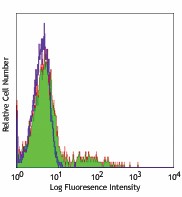
-

Human peripheral blood lymphocytes stained with purified LN2, followed by anti-mouse IgG FITC
| Cat # | Size | Price | Quantity Check Availability | Save | ||
|---|---|---|---|---|---|---|
| 326802 | 100 µg | 96€ | ||||
CD74 is a type II transmembrane glycoprotein also known as MHC class II associated invariant chain, invariant chain, Ii, MHC class II chaperone, and MIF receptor. CD74 exists in four isoforms with molecular masses of 33, 35, 41, and 43 kD, depending on genetic splicing. CD74 is primarily expressed on antigen presenting cells, including B cells, monocytes/macrophages, dendritic cells, and Langerhans cells. It is also expressed by activated T cells and activated endothelial and epithelial cells as well as carcinomas of lung, renal, gastric and thymic origin. The primary function of CD74 is intracellular sorting of MHC class II molecules and regulation of exogenous peptide loading onto MHC class II. It is also involved in the modulation of B cell differentiation and positive selection of CD4+ T cells. It has been reported that CD74 binds MIF (macrophage migration inhibitory factor) and signals through CD44 to regulate innate and adaptive immunity. It is also reported that H. pylori infection occurs through urease B binding of CD74 on gastric epithelial cells, inducing gastric epithelial cell apoptosis, NF-κB activation, and IL-8 production.
Product DetailsProduct Details
- Verified Reactivity
- Human, Cynomolgus, Rhesus
- Reported Reactivity
- African Green, Baboon
- Antibody Type
- Monoclonal
- Host Species
- Mouse
- Immunogen
- SU-DHL-4 cells
- Formulation
- Phosphate-buffered solution, pH 7.2, containing 0.09% sodium azide.
- Preparation
- The antibody was purified by affinity chromatography.
- Concentration
- 0.5 mg/mL
- Storage & Handling
- The antibody solution should be stored undiluted between 2°C and 8°C.
- Application
-
FC - Quality tested
IHC, IP, ICC - Reported in the literature, not verified in house - Recommended Usage
-
Each lot of this antibody is quality control tested by immunofluorescent staining with flow cytometric analysis. For flow cytometric staining, the suggested use of this reagent is ≤ 2.0 µg per 106 cells in 100 µL volume or 100 µL whole blood. It is recommended that the reagent be titrated for optimal performance for each application.
- Application Notes
-
Clone LN2 is reactive with an epitope residing within 60 amino acids of the extracytoplasmic, COOH terminus of the protein.3
Additional reported applications (for the relevant formats) include: immunohistochemical staining1,2 of frozen sections and formalin-fixed paraffin-embedded sections1,2, immunoprecipitation1, and immunofluorescence4. -
Application References
(PubMed link indicates BioLegend citation) -
- Epstein AL, et al.1984. J. Immunol. 133:1028. (IHC, IP)
- Marder RJ, et al. 1985. Lab. Invest. 52:497. (IHC)
- Wraight CJ, et al. 1990. J. Biol. Chem. 265:5787.
- Leng L, et al. 2003. J. Exp. Med. 197:1467. (IF)
- Product Citations
-
- RRID
-
AB_893401 (BioLegend Cat. No. 326802)
Antigen Details
- Structure
- Type II transmembrane glycoprotein, 33, 35, 41, 43 kD
- Distribution
-
B cells and other antigen presenting cells, activated T cells, activated endothelial and epithelial cells, and certain carcinomas
- Function
- Regulates loading of exogenous peptides onto MHC class II and B cell differentiation, involved in positive selection of CD4+ T cells.
- Ligand/Receptor
- HLA-DR, MIF, H. pylori urease B, associates with CD44
- Cell Type
- Antigen-presenting cells, B cells, Endothelial cells, Epithelial cells, T cells, Tregs
- Biology Area
- Immunology
- Molecular Family
- CD Molecules, MHC Antigens
- Antigen References
-
1. Moldenhauer G, et al. 1999. Immunology 96:473.
2. Shi X, et al. 2006. Immunity 25:595.
3. Beswick EJ, et al. 2006. Infect. Immun. 74:1148.
4. Zola H,et al. 2007. Leukocyte and Stromal Cell Molecules:The CD Markers Wiley-Liss A John Wiley & Sons Inc, Publication - Gene ID
- 972 View all products for this Gene ID
- UniProt
- View information about CD74 on UniProt.org
Related FAQs
Other Formats
View All CD74 Reagents Request Custom Conjugation| Description | Clone | Applications |
|---|---|---|
| Purified anti-human CD74 | LN2 | FC,IHC,IP,ICC |
| PE anti-human CD74 | LN2 | FC |
| APC anti-human CD74 | LN2 | FC |
| TotalSeq™-C0935 anti-human CD74 Antibody | LN2 | PG |
| TotalSeq™-D0935 anti-human CD74 | LN2 | PG |
| TotalSeq™-B0935 anti-human CD74 | LN2 | PG |
| TotalSeq™-A0935 anti-human CD74 | LN2 | PG |
Customers Also Purchased
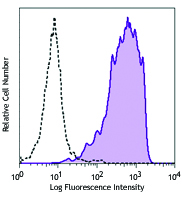

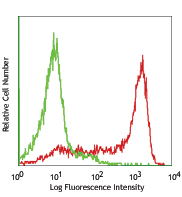
Compare Data Across All Formats
This data display is provided for general comparisons between formats.
Your actual data may vary due to variations in samples, target cells, instruments and their settings, staining conditions, and other factors.
If you need assistance with selecting the best format contact our expert technical support team.
-
Purified anti-human CD74
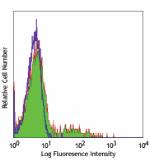
Human peripheral blood lymphocytes stained with purified LN2... -
PE anti-human CD74
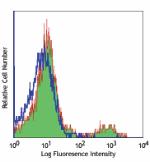
Human peripheral blood lymphocytes stained with LN2 PE -
APC anti-human CD74
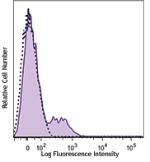
Human peripheral blood lymphocytes were stained with anti-CD... -
TotalSeq™-C0935 anti-human CD74 Antibody
-
TotalSeq™-D0935 anti-human CD74
-
TotalSeq™-B0935 anti-human CD74
-
TotalSeq™-A0935 anti-human CD74
 Login / Register
Login / Register 









Follow Us